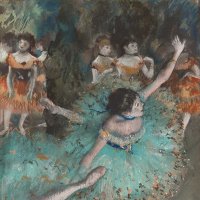Patriotic Demonstration
“We will sing of great crowds excited by work, by pleasure, and by riot; we will sing of the multicolored, polyphonic tides of revolution in the modern capitals.” These words, written by Marinetti in the First Futurist Manifesto of 1909, acquire a premonitory nature when we view the present Patriotic Demonstration painted by Balla in 1915. The painting belongs to a series devoted to the demonstrations staged in Rome to urge Italy to join the war, a decision finally made in May 1915. Both Balla and the other Futurists, driven by their youthful enthusiasm, made interventionism their raison d’être. Their nationalistic spirit led them to passionately exalt the war: “We wish to glorify war — the sole cleanser of the world.”
Patriotic Demonstration, which depicts fluttering three-coloured green, white and red Italian flags that envelop a compact crowd, is Balla’s interpretation of one of these interventionist demonstrations. Although it is not known which particular demonstration Balla painted in this work, the fact that the expression “Morte Giolitti” features in one of the preliminary studies for the composition has led Christopher Green to suggest it was the gathering outside Rome station on 9 March 1915 in protest against the arrival of the neutralist politician Giovanni Giolitti. However, this author also suggests that the incorporation of the number 8 — the emblem of the House of Savoy, whose head, the Italian king, was a staunch interventionist — may indicate that it was the demonstration organised by the writer Gabriele D’Annunzio in Rome’s Piazza Quirinale on 21 March 1915 in which Vittorio Emanuele came out onto the balcony of the royal palace and shouted “Long Live Italy!”
There are several versions on this theme related to the Museo Thyssen-Bornemisza painting and many other works by Balla on these tumultuous events. Nearly all of them are characterised by the explosion of the colours of the Italian flag, which intensify the violent spirals of the composition. Umberto Boccioni lavished enthusiastic praise on these works when they were exhibited in 1918: “His latest works, inspired by the violent anti neutral demonstrations, have achieved matchless results in Europe today. There is no longer only an objective plastic value, everything has been transformed by the idea of dynamism, interpreted as an intuitive sense of abstraction.”
Indeed, from late 1912 onwards, Giacomo Balla focused on a plastic exploration of dynamic nature, coming close to abstraction. When speed emerged as a new myth, Balla, like the other young Futurists, keenly sought images capable of representing the pace of modern times. His initial study of the passage of cars through the streets of Rome was followed by the depiction of these demonstrations, which were intended to convey sensations of the movement and sound of urban life. Using what he called “lines of speed, ” he attempted to create an abstract equivalent of the universe, the theory behind which he explained in a manifesto he and Fortunato Depero signed in 1915: “We will find abstract equivalents for every form and element in the universe, and then we will combine them according to the caprice of our inspiration, creating plastic complexes which we will set in motion.”
The painting’s first owner was the Russian choreographer Léonide Massine (1896–1979), who acquired it directly from the artist in April 1917 for the premiere of Igor Stravinsky’s Feu d’artifice at the Teatro Constanzi in Rome. Giacomo Balla designed the stage sets for this performance by Diaghilev’s Ballets Russes with choreography by Léonide Massine.
Paloma Alarcó
Emotions through art
This artwork is part of a study we conducted to analyze people's emotional responses when observing 125 pieces from the museum.










